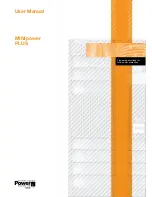
INSTALLING YOUR UPS SYSTEM
- continued
6. If an overload is detected, an audible alarm
will sound and the unit will emit one long
beep. To correct this, turn the UPS off and
unplug at least one piece of equipment
from the battery power supplied outlets.
Make sure the circuit breaker is depressed
and then turn the UPS on.
7. To maintain optimal battery charge, leave
the UPS plugged into an AC outlet at
all times.
8. To store the UPS for an extended period
of time, cover it and store with the battery
fully charged. While in storage, recharge
the battery every three months to ensure
optimal battery life.
9. The socket-outlet shall be installed near the
equipment and shall be easily accessible.
BASIC OPERATION
1. LCD module display
LCD shows all the UPS information with
icons and messages.
2. Power On Indicator
This LED is illuminated when the utility
condition is normal and the UPS outlets are
providing power, free of surges and spikes.
3. Power Switch
Master on/off switch for equipment
connected to the battery power
supplied outlets.
4. LCD function selected switch
The switch can be used to select the LCD
display contents Including input/output
voltage and estimated run time, etc.
5. Battery and Surge Protected Outlets
The unit has four battery powered/
surge suppression outlets for connected
equipment to ensure temporary
uninterrupted operation of your equipment
during a power failure. (DO NOT plug a
laser printer, paper shredder, copier, space
heater, vacuum cleaner, sump pump or
other large electrical devices into the
“Battery and Surge Protected Outlets”.
The power demands of these devices may
overload and damage the unit.)
6. Full-Time Surge Protection Outlets
The unit has two surge suppression outlets.
7. SNMP/HTTP Network Slot
Remove the cover panel to install an
optional RMCARD provides remote
monitoring and management of your UPS
over a network.
8. Communication Protection Ports RJ45
Communication protection ports,
bi-directional, will protect a
10/100/1000Ethernet connection. (RJ45).
9. USB Port to PC
This port allows connection and
communication from the USB port on
the computer to the UPS unit. The UPS
communicates its status to the PowerPanel®
Business Edition software.
10. Dry contact
This port produces information for
equipment that can read dry contact
signals.
11. Circuit Breaker
Located on the back of the UPS, the circuit
breaker serves to provide overload and
fault protection. Under normal operating
conditions, the circuit breaker is depressed.
12. AC Input
Connect the AC Power cord to a properly
wired and grounded outlet.
13. Electrical Wiring Fault Indicator (Red)
This LED indicator will illuminate to warn
the user that a wiring problem exists, such
as bad ground, missed ground or reversed
wiring. If this is illuminated, disconnect all
electrical equipment from the outlet and
have an electrician check to ensure the
outlet is properly wired. The unit will not
provide surge protection without being
plugged into a grounded and properly
wired wall outlet.



























